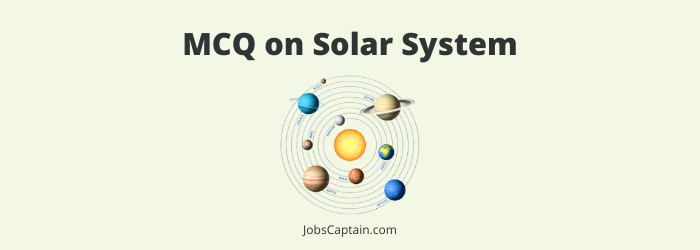
Question 1. Which of the following words best describes the shape of our galaxy?
(A) Barred-spiral
(B) Spiral
(C) Elliptical
(D) Spherical
Question 2. A first magnitude star is how many times brighter than a second magnitude star?
(A) 12.0
(B) 10.0
(C) 7.3
(D) 2.5
Question 3. Cassini’s division is described by which of the following?
(A) The distance between the Van Allen belts
(B) The distance between the first two moons of Jupiter
(C) A break in the clouds of Jupiter
(D) A break in the rings of Saturn
Question 4. The angle that the full moon takes up in the night sky is equal to which of the following values?
(A) 2 degrees
(B) 1 degree
(C) 1/2 degrees
(D) 1/8 degree
Question 5. At any time we may describe the position of an inferior planet by the angle it makes with the sun as seen from the earth. This angle is called the _____________.
(A) Proxima
(B) Elongation
(C) Epicycle
(D) Ecliptic
Question 6. In the Milky Way there are approximately _____________.
(A) 200 billion stars
(B) 400 million stars
(C) 100 million stars
(D) 2 million stars
Question 7. A Galactic year is the length of time that it takes our sun to orbit the galaxy. In Earth years, how long is a Galactic year?
(A) 940 million years
(B) 620 million years
(C) 230 million years
(D) 100 million years
Question 8. Galileo discovered something about Venus with his telescope that shook the old theories. Which of the following was Galileo’s discovery?
(A) Venus had retrograde motion
(B) Venus’ surface was similar to the earth’s
(C) Venus had phases like the moon
(D) Venus was covered in clouds
Question 9. Which planet seems to be turned on its side with an axis tilt of 98 degrees?
(A) Saturn
(B) Neptune
(C) Pluto
(D) Uranus
Question 10. A planet is said to be at aphelion when it is _____________.
(A) At it’s lowest point below the ecliptic
(B) At it’s highest point above the ecliptic
(C) Farthest from the sun
(D) Closest to the sun
Question 11. A pulsar is actually a _____________.
(A) Neutron star
(B) Red giant
(C) White dwarf
(D) Black hole
Question 12. In the lowest level of the photosphere of the Sun, the temperature is _____________.
(A) 13,000 degrees Kelvin
(B) 10,000 degrees Kelvin
(C) 6,000 degrees Kelvin
(D) 1,000 degrees Kelvin
Question 13. The word Albedo (pron: al-BEE-doe) refers to which of the following?
(A) The brightness of a star
(B) The phase changes of a planet
(C) The amount of light a planet reflects
(D) The wobbling motion of a planet
Question 14. On which of the following planets would the sun rise in the west?
(A) Venus
(B) Mercury
(C) Pluto
(D) Saturn
Question 15. The cosmic background radiation, a remnant of the Big Bang, is at what temperature?
(A) 2.7K
(B) 5.3K
(C) 0K
(D) 100K
Question 16. A line through the three stars in Orion’s belt points toward which one of the following stars?
(A) Rigel
(B) Sirius
(C) Polaris
(D) Mizor
Question 17. The orbital plane of the moon is how many degrees inclined from the ecliptic?
(A) 0 degrees
(B) 5 degrees
(C) 10 degrees
(D) 15 degrees
Question 18. When a superior planet is at opposition it is making an angle of how many degrees with the sun?
(A) 180 degrees
(B) 90 degrees
(C) 45 degrees
(D) 0 degrees
Question 19. The largest moon in our solar system has an atmosphere that is denser than the atmosphere of Mars. The name of this moon is _____________.
(A) Io
(B) Triton
(C) Ganymede
(D) Titan
Question 20. The LAST manned moon flight was made in what year?
(A) 1974
(B) 1973
(C) 1972
(D) 1971
Question 21. Which of the following constellations has more bright stars than any other constellation?
(A) Scorpion
(B) Orion
(C) Cassiopeia
(D) Big Dipper
Question 22. Name the phase that the moon is in for each type of eclipse, lunar and solar _____________.
(A) New moon for lunar and full moon for solar
(B) Full moon for lunar and new moon for solar
(C) New moon for both phases
(D) Full moon for both phases
Question 23. The period from one full moon to the next is _____________.
(A) 28 days
(B) 29.5 days
(C) 30 days
(D) 30.3 days
Question 24. Which of the following planets has the greatest eccentricity?
(A) Mercury
(B) Mars
(C) Jupiter
(D) Pluto
Question 25. Which of the following first hypothesized that the Earth orbited the sun?
(A) Tycho Brahe
(B) Socrates
(C) Copernicus
(D) Alexander the Great
